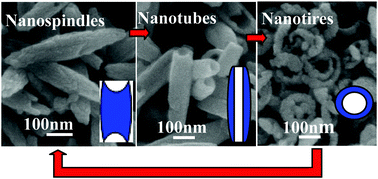By employing a high throughput method under hydrothermal conditions, nanospindles, nanotubes, nanotires, and nanospindles, occurring periodically in hematite with increasing reaction time, were investigated. A formation–dissolution–reformation mechanism of periodical structural conversion during the growth process was put forward based on X-ray diffraction (XRD), scanning electron microscopy (SEM), transmission electron microscopy (TEM), and high-resolution transmission electron microscopy (HRTEM). Phosphate ions play an important role in converting nanostructures of hematite from nanospindles, to nanotubes, to nanotires, owing to their selective adsorption on the different crystallographic planes of hematite and the coordination effect with Fe3+. The mesophase of Fe4(PO4)3(OH)3 balances the concentration of OH− anions and determines the dissolution and reformation process of the subsequent reactions. Thus, the morphology transition from nanotires to nanospindles takes place, and the periodical structural conversion phenomenon occurs. The results from magnetic measurements indicated that the nanostructures observed herein did not show a Morin transition between 2 and 350 K.

